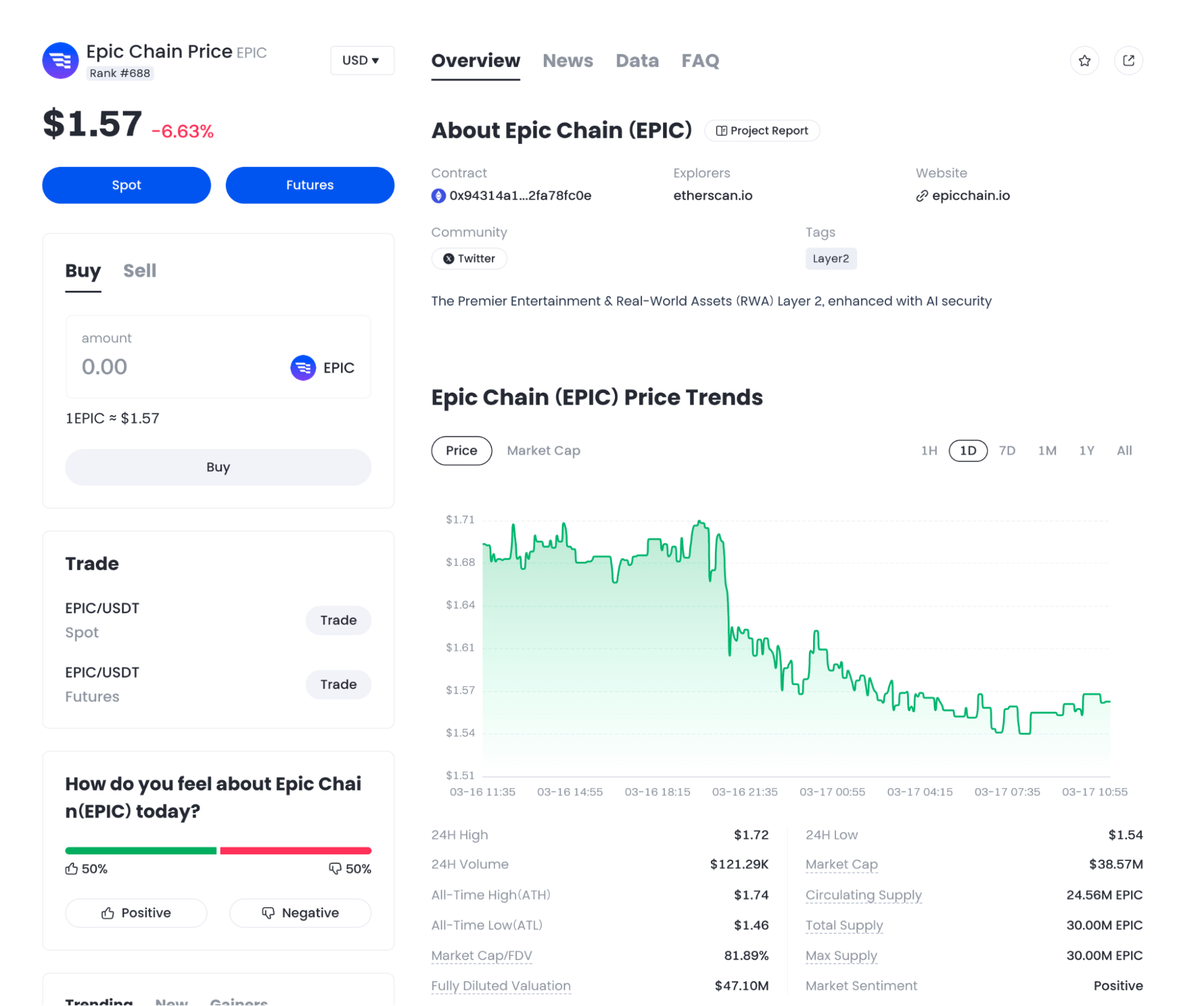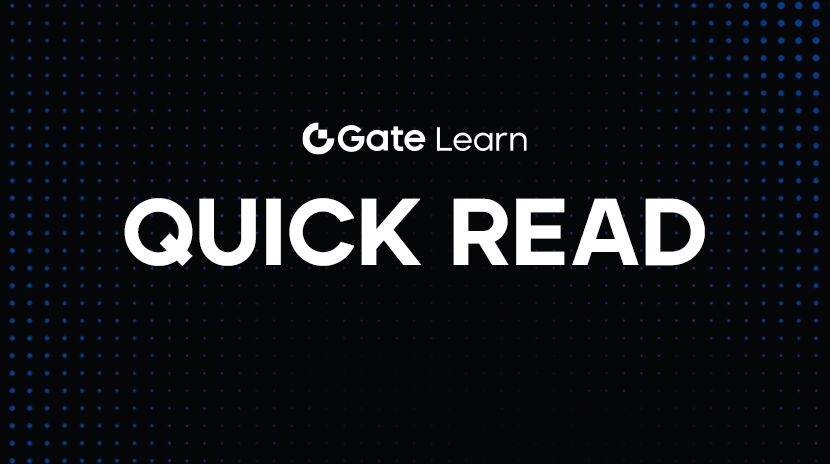O que é Epic Chain (EPIC): Um Protocolo da Camada 2 Focado em RWA
1. Introdução
1.1 Antecedentes e Objetivo
No atual desenvolvimento rápido da tecnologia blockchain, a Epic Chain, como um projeto muito aguardado na indústria, está gradualmente emergindo. Desde o surgimento da blockchain a partir do Bitcoin, expandiu-se de uma aplicação simples de moeda digital para muitos campos, como finanças, cadeia de abastecimento, saúde, entretenimento, etc., mudando mecanismos de confiança e processos de negócios tradicionais. Com sua arquitetura técnica única e modelo de aplicação inovador, a Epic Chain assegurou uma posição importante no competitivo mercado blockchain.
A emergência da Epic Chain não só fornece novas ideias para os cenários de aplicação da tecnologia blockchain, mas também traz novas oportunidades e desafios para investidores, desenvolvedores e profissionais da indústria relacionada. A sua implantação no ecossistema da Camada 2, bem como a integração de Ativos do Mundo Real (RWAs) e da indústria do entretenimento, tem atraído muita atenção e recursos.

Inicie sessão na plataforma de negociação Gate.com e comece a negociar EPIC instantaneamente:https://www.Gate.com/trade/EPIC_USDT
2. Visão geral da Epic Chain
2.1 Histórico de Desenvolvimento
A Epic Chain, anteriormente conhecida como Ethernity Chain, passou por uma série de etapas importantes de desenvolvimento no campo da blockchain, emergindo gradualmente e completando a transformação estratégica e atualização. Desde a sua fundação, a Ethernity Chain tem explorado ativamente a aplicação da tecnologia blockchain e está empenhada em construir um ecossistema único. Durante o seu desenvolvimento, a Ethernity Chain tem se concentrado na aplicação da tecnologia blockchain em campos específicos, acumulado uma certa base técnica e base de usuários e alcançado resultados preliminares em áreas como NFT e negociação de ativos digitais.
À medida que a tecnologia blockchain continua a desenvolver-se e as exigências do mercado mudam, a Ethernity Chain reconhece a necessidade de expandir ainda mais o seu âmbito de negócios e melhorar o desempenho técnico para se adaptar ao mercado de blockchain cada vez mais competitivo. Após uma pesquisa aprofundada e discussões comunitárias, a Ethernity Chain decidiu atualizar estrategicamente e renomear-se oficialmente Epic Chain em 10 de fevereiro de 2025. Esta mudança de nome não se trata apenas de uma alteração de marca, mas sim de uma mudança significativa na direção de desenvolvimento do projeto, assinalando a entrada da Epic Chain numa nova fase do ecossistema blockchain da Camada 2.
Após a renomeação, a Epic Chain iniciou uma troca de tokens 1:1, convertendo os tokens ERN originais em tokens EPIC. Esta medida, apoiada por até 97,1% através de uma votação da comunidade DAO, reflete plenamente o reconhecimento e as expectativas da comunidade para a atualização do projeto. O token EPIC herda todas as funcionalidades do ERN e as expande, estendendo seus cenários de aplicação ao ecossistema da Camada 2, abrangendo aspectos como staking, negociação, governança e muito mais. Esta troca de tokens e expansão de funcionalidades estabelecem uma base sólida para o desenvolvimento subsequente da Epic Chain, permitindo uma melhor integração de ativos do mundo real (RWAs) e do setor de entretenimento, impulsionando o crescimento a longo prazo do ecossistema.
Em 13 de março de 2025, a Gate.com completou a substituição de tokens da Ethernity Chain (ERN) e rebatizou-a como Epic Chain (EPIC), abrindo novos serviços de depósito e levantamento de tokens EPIC, e também abriu negociação à vista de EPIC/USDT. Esta colaboração aumenta ainda mais a influência de mercado e a liquidez da Epic Chain, trazendo-lhe mais atenção no mercado de criptomoedas.

2.2 Conceitos Básicos e Posicionamento
A Epic Chain é um projeto de ecossistema blockchain posicionado na Camada 2. A Camada 2, como uma solução global de escalabilidade para melhorar o desempenho da rede Ethereum (Camada 1), tem como objetivo processar algumas transações construindo uma rede de camada 2 off-chain sem modificar diretamente as regras, como o tamanho do bloco da Camada 1, aliviando assim a pressão sobre a cadeia principal e alcançando resultados de transações com taxas de gás baixas. Aproveitando a tecnologia da Camada 2, a Epic Chain pode aumentar efetivamente a capacidade de processamento de transações, aliviar problemas de congestionamento na cadeia principal do Ethereum e reduzir os custos de transação para os usuários.
A posição central da Epic Chain é integrar Ativos do Mundo Real (RWAs) com a indústria do entretenimento. Em termos de integração de ativos do mundo real, a Epic Chain está comprometida em introduzir ativos financeiros tradicionais, ativos físicos, etc., no ecossistema blockchain, digitalizando e tokenizando ativos através da tecnologia blockchain, melhorando a liquidez e negociabilidade de ativos, trazendo nova vitalidade e inovação aos mercados tradicionais de ativos. Por exemplo, a Epic Chain pode digitalizar ativos reais como imóveis, arte, ações, etc., permitindo que sejam negociados e circulem na blockchain, quebrando as limitações geográficas e temporais das transações de ativos tradicionais e fornecendo canais de investimento mais convenientes para investidores globais.
Na indústria do entretenimento, a Epic Chain combina as características da tecnologia blockchain para trazer uma nova experiência e modelo de negócio para a indústria do entretenimento. Através da descentralização e resistência à adulteração da blockchain, a Epic Chain pode realizar a verdadeira propriedade dos adereços de jogo pertencentes aos jogadores. Os jogadores podem negociar livremente, transferir adereços de jogo e até participar no desenvolvimento e governança do jogo. Ao mesmo tempo, a Epic Chain também pode fornecer uma plataforma de distribuição descentralizada e proteção de direitos autorais para conteúdos de entretenimento como música, filmes e animação. Os criadores podem interagir diretamente com os fãs, obter uma renda mais razoável e os consumidores também podem ter acesso a conteúdos de entretenimento mais qualificados e personalizados.
A Epic Chain, como um projeto ecológico blockchain da Camada 2, integra ativos do mundo real e a indústria do entretenimento, abrindo novos caminhos para a aplicação da tecnologia blockchain. Espera-se que desempenhe um papel importante no futuro mercado de blockchain, promovendo a inovação e o desenvolvimento da indústria.
3. Análise do princípio da tecnologia Epic Chain
3.1 Arquitetura de Tecnologia Central
O Epic Chain, como um projeto de ecossistema blockchain de Camada 2, tem sua arquitetura técnica central girando em torno da melhoria do desempenho da rede Ethereum, integrando ativos do mundo real com o setor de entretenimento e tendo vários componentes chave.
A nível técnico subjacente, a Epic Chain construiu uma rede Camada 2 baseada na cadeia principal do Ethereum, alcançando um processamento eficiente de transações ao adotar a tecnologia Rollup. A tecnologia Rollup comprime uma grande quantidade de dados de transação em um lote, que é então submetido à cadeia principal do Ethereum para verificação e armazenamento. Dessa forma, a cadeia principal só precisa processar uma pequena quantidade de dados resumidos, sem precisar processar cada transação individual, aumentando significativamente a capacidade de transação e reduzindo os custos de transação. Por exemplo, em transações tradicionais do Ethereum, cada transação precisa ser verificada e registrada na cadeia principal, resultando em uma velocidade lenta de processamento de transações e altas taxas de gás. Por outro lado, a Epic Chain utiliza a tecnologia Rollup para agrupar várias transações em um lote e submetê-las à cadeia principal, onde a cadeia principal só precisa verificar a validade desse lote, reduzindo significativamente a carga na cadeia principal, permitindo que as transações sejam concluídas rapidamente na rede Camada 2 e reduzindo significativamente os custos de transação para os usuários.
Em termos de mecanismo de consenso, a Epic Chain adotou um mecanismo de consenso híbrido inovador que combina as vantagens do Proof of Stake (PoS) e da Tolerância a Falhas Bizantinas Práticas (PBFT). O mecanismo PoS seleciona validadores com base na quantidade de tokens mantidos pelos nós e na duração da retenção, com nós que mantêm mais tokens por um período mais longo tendo uma probabilidade maior de serem selecionados, aumentando assim a segurança e eficiência da rede. O mecanismo PBFT, por outro lado, garante a consistência e confiabilidade da rede mesmo na presença de nós maliciosos. Ao combinar esses dois mecanismos, a Epic Chain consegue garantir a descentralização, ao mesmo tempo que alcança uma rápida confirmação de transações e uma operação eficiente da rede. Por exemplo, em algumas redes de blockchain que adotam um único mecanismo PoS, pode haver problemas de centralização dos nós validadores, afetando a segurança e descentralização da rede. No entanto, o mecanismo de consenso híbrido da Epic Chain, complementado pelo mecanismo PBFT, impede eficazmente ataques de nós maliciosos e garante a operação estável da rede em várias circunstâncias.
Em termos de contratos inteligentes, a Epic Chain suporta a Máquina Virtual Ethereum (EVM), o que significa que os programadores podem utilizar ferramentas e linguagens de desenvolvimento Ethereum familiares, como Solidity, para desenvolver e implementar contratos inteligentes. Ao mesmo tempo, a Epic Chain otimizou contratos inteligentes, melhorando a eficiência e segurança dos contratos. Por exemplo, a Epic Chain introduziu mecanismos de auditoria e monitorização de contratos inteligentes, realizando auditorias abrangentes de segurança do código do contrato, monitorizando o estado de execução dos contratos em tempo real, identificando e resolvendo prontamente potenciais vulnerabilidades de segurança para garantir a segurança dos ativos do utilizador.
A arquitetura de tecnologia central da Epic Chain fornece um forte suporte para funções como staking, trading, governance, etc. através da rede Camada 2, mecanismo de consenso inovador e contratos inteligentes otimizados, realizando um ecossistema blockchain eficiente, seguro e descentralizado.
3.2 Pontos de Inovação Tecnológica
A Epic Chain tem muitos pontos inovadores em tecnologia, que fornecem uma forte força motriz para o seu desenvolvimento ecológico.
O mecanismo aprimorado de recompensa de staking lançado pela Epic Chain é uma das suas inovações importantes. No mecanismo tradicional de recompensa de staking, os utilizadores só podem receber um rendimento único ao fazer staking de tokens, enquanto o mecanismo aprimorado de recompensa de staking da Epic Chain permite aos utilizadores receber recompensas de tokens de outros projetos emitidos na Epic Chain ao fazer staking de tokens EPIC. Este mecanismo aumenta significativamente o entusiasmo dos utilizadores para participar no staking e enriquece as suas fontes de rendimento. Por exemplo, supondo que um novo projeto de jogo é emitido com os seus tokens na Epic Chain, os utilizadores podem participar no pool de staking do projeto ao fazer staking de tokens EPIC, não só recebendo recompensas de staking para os tokens EPIC, mas também recebendo recompensas de tokens para o projeto de jogo com base na proporção de staking. Isto permite aos utilizadores apoiar o desenvolvimento do ecossistema da Epic Chain enquanto partilham os dividendos trazidos pelo desenvolvimento de outros projetos, promovendo a interação e cooperação entre vários projetos dentro do ecossistema.
A Epic Chain adotou uma solução técnica única para integrar Ativos do Mundo Real (RWAs). Através da tecnologia de tokenização na blockchain, ativos no mundo real como imóveis, obras de arte, ações, etc., são mapeados para ativos digitais na blockchain. Ao mesmo tempo, ao utilizar a tecnologia oracle para conectar dados do mundo real com a blockchain, garante a correspondência precisa e confiável entre o valor dos ativos digitais e os ativos reais. Por exemplo, para um ativo imobiliário, a Epic Chain pode tê-lo avaliado por uma agência de avaliação profissional, então o resultado da avaliação é colocado na cadeia através de um oracle, e uma quantidade correspondente de tokens é emitida com base nesse ativo imobiliário. Esses tokens podem ser negociados e circulados na Epic Chain, realizando a digitalização e a melhoria da liquidez dos ativos imobiliários, proporcionando um caminho viável para a integração dos mercados de ativos tradicionais e mercados blockchain.
No setor do entretenimento, a Epic Chain utiliza a tecnologia blockchain para alcançar a verdadeira propriedade de itens no jogo para os jogadores. Os itens obtidos pelos jogadores no jogo são armazenados na blockchain na forma de NFTs (Tokens Não Fungíveis), dando aos jogadores controle total sobre esses itens, permitindo-lhes negociá-los, transferi-los e hipotecá-los livremente. Por exemplo, num jogo suportado pela Epic Chain, itens raros de armas obtidos pelos jogadores são criados como NFTs. Os jogadores podem vender esses itens a outros jogadores no mercado do jogo ou em plataformas externas de negociação de NFTs, obtendo lucros correspondentes. Este modelo inovador de propriedade de itens no jogo quebra a limitação tradicional em que os jogadores apenas têm o direito de usar os itens, proporcionando aos jogadores uma nova experiência de jogo e valor econômico.
As inovações tecnológicas da Epic Chain promovem a participação do usuário e a colaboração em projetos ecológicos através de um mecanismo aprimorado de recompensa de staking, integram ativos tradicionais com blockchain através da tecnologia de integração de RWAs, trazem novas experiências e valor aos jogadores através de aplicações inovadoras no campo do entretenimento, e promovem eficazmente o desenvolvimento e crescimento de seu ecossistema.

4. Perspetivas sobre o desenvolvimento atual da Epic Chain
4.1 Desempenho do Mercado
4.1.1 Análise de Tendências de Preços
A partir da tendência de preços históricos, o token EPIC da Epic Chain experimentou flutuações de preços significativas após completar a atualização da marca e a substituição do token em 10 de fevereiro de 2025. Na fase inicial da listagem, devido ao apoio das principais plataformas de negociação e expectativas de mercado para seu ecossistema de Camada 2 e conceito de integração de ativos do mundo real, o preço do token EPIC viu um aumento rápido. Após a Gate.com listar os pares de negociação EPIC em 13 de março de 2025, o preço rapidamente disparou desde o preço inicial para atingir um patamar alto. No entanto, à medida que o mercado esfriava gradualmente e a flutuação do mercado global de criptomoedas, o preço do EPIC subsequentemente entrou em um período de ajuste.
A longo prazo, a tendência de preços da Epic Chain será influenciada por vários fatores, incluindo o desenvolvimento de seu ecossistema, inovação tecnológica e competição de mercado. Se a Epic Chain implementar com sucesso mais projetos de integração de ativos do mundo real, atrair mais usuários e desenvolvedores e aumentar a atividade do ecossistema, é provável que seu preço mantenha uma tendência de alta a longo prazo. No entanto, se a competição de mercado se intensificar ou o projeto enfrentar desafios na implementação tecnológica e promoção de aplicações, o preço pode continuar a enfrentar pressão descendente. Com base na análise técnica atual e nas condições de mercado, espera-se que o preço da EPIC flutue dentro de uma certa faixa a curto prazo, aguardando novos fatores impulsionadores do mercado.

5. Análise dos cenários de aplicação da Epic Chain
5.1 Integração de Ativos do Mundo Real (RWAs)
5.1.1 Casos de Aplicação Específicos
A Epic Chain tem vários casos de uso bem-sucedidos na integração de ativos do mundo real. Tomando a sua cooperação com um conhecido projeto imobiliário como exemplo, o projeto digitalizou e tokenizou imóveis comerciais em uma cidade de primeira linha. A Epic Chain realizou primeiro uma avaliação abrangente dos imóveis comerciais por uma agência profissional de avaliação de ativos para determinar o seu valor de mercado. Em seguida, a propriedade do imóvel foi dividida em ativos digitais em certa proporção e emitida sob a forma de NFTs na Epic Chain. Estes NFTs representam a propriedade parcial do imóvel comercial, e os detentores podem receber dividendos de renda correspondentes pela posse dos NFTs, e podem negociar livremente esses NFTs no mercado da Epic Chain.
No processo de implementação do projeto, Epic Chain garante a transparência e segurança das transações usando contratos inteligentes. O contrato inteligente especifica em detalhe a distribuição de renda de aluguel, as regras de negociação de NFTs e o processo de transferência de direitos de propriedade. Por exemplo, quando um novo investidor compra um NFT, o contrato inteligente atualizará automaticamente as informações de propriedade e distribuirá a renda de aluguel subsequente de acordo com a nova proporção de participação. Ao mesmo tempo, por meio da tecnologia oracle, Epic Chain pode obter dados operacionais em tempo real do imobiliário comercial, como renda de aluguel, taxa de vacância, etc., para garantir que os investidores possam entender pontualmente a situação real dos ativos.
5.2 Aplicações no Setor do Entretenimento
5.2.1 O formulário de aterragem da indústria do entretenimento
A Epic Chain tem uma variedade de formas de aterragem na indústria do entretenimento, abrangendo música, filmes, jogos e outros campos. No campo da música, a Epic Chain fornece uma plataforma descentralizada de distribuição e gestão de direitos autorais para os criadores de música. Os criadores podem lançar as suas obras musicais sob a forma de NFT na Epic Chain para obter a confirmação dos direitos autorais das suas obras. Cada NFT de música contém informações detalhadas sobre a obra, como o criador, a data de lançamento, o conteúdo da faixa, etc., e estas informações são registadas permanentemente na blockchain e não podem ser adulteradas.
Ao mesmo tempo, através de contratos inteligentes, os criadores podem estabelecer contato direto com os fãs, alcançar vendas diretas de obras musicais e partilha de receitas. Depois de os fãs comprarem NFTs de música, não só possuem a propriedade digital das obras musicais, mas também podem participar na promoção e disseminação das obras musicais, e receber recompensas correspondentes. Por exemplo, quando os fãs partilham o link do NFT de música e orientam com sucesso outros a efetuar uma compra, o contrato inteligente distribuirá automaticamente uma certa percentagem da partilha de receitas aos fãs, incentivando os fãs a participar ativamente na promoção das obras musicais.
No campo do cinema e televisão, a Epic Chain fornece uma solução completa de processo para financiamento, produção, distribuição e gestão de direitos de autor para projetos cinematográficos. Os projetos cinematográficos podem angariar fundos através da emissão de NFTs na Epic Chain, e os investidores tornam-se acionistas do projeto após adquirirem NFTs, desfrutando dos direitos de receita do projeto. Durante o processo de produção, a Epic Chain utiliza a rastreabilidade da blockchain para monitorizar o fluxo de fundos e o progresso de produção de projetos cinematográficos em tempo real, garantindo a transparência e justiça do projeto.
Na fase de lançamento, obras de cinema e televisão podem ser distribuídas globalmente na Epic Chain sob a forma de NFTs, quebrando as restrições geográficas e intermediários da distribuição tradicional de cinema e televisão. Após a compra de um NFT de filme e TV, os espectadores podem assistir ao filme e à obra de TV em qualquer dispositivo que suporte a Epic Chain, e podem comentar sobre o filme e a obra de TV e partilhá-la de forma interativa. Ao mesmo tempo, através de contratos inteligentes, os criadores de cinema e televisão e investidores podem obter uma partilha de receitas correspondente de acordo com o número de visualizações e interações das obras de cinema e televisão.
No setor de jogos, a aplicação da Epic Chain é mais extensa. Os desenvolvedores de jogos podem utilizar a tecnologia da Epic Chain para colocar adereços de jogo, personagens, cenários e outros ativos na cadeia na forma de NFT, alcançando a verdadeira propriedade de ativos de jogo para os jogadores. Os jogadores podem negociar livremente e transferir esses ativos NFT no jogo ou em mercados externos para obter benefícios econômicos. Por exemplo, em um jogo de interpretação baseado na Epic Chain, equipamentos raros obtidos pelos jogadores por meio de tarefas e derrotando monstros são cunhados em NFTs. Os jogadores podem vender esses equipamentos no mercado do jogo para outros jogadores em troca de moedas de jogo ou moeda real.
Ao mesmo tempo, a Epic Chain também fornece um mecanismo de governação descentralizada de jogos para os desenvolvedores de jogos. Através de contratos inteligentes, os jogadores podem participar na tomada de decisões e governação do jogo, como votar em atualizações do jogo, ajustes de equilíbrio, etc. Este mecanismo de governação descentralizada aumenta o sentido de participação e pertença dos jogadores ao jogo, e promove o desenvolvimento saudável da comunidade de jogos.

6. A Epic Chain enfrenta desafios
6.1 Desafios Técnicos
A Epic Chain enfrenta vários desafios no desenvolvimento técnico, como otimização de desempenho e melhoria da segurança. Em termos de otimização de desempenho, embora a Epic Chain adote a tecnologia Camada 2 para aumentar a capacidade de processamento de transações, a escalabilidade da rede ainda enfrenta pressão à medida que o número de usuários e o volume de transações continuam a crescer. Por exemplo, durante os períodos de transação de pico, a rede Camada 2 pode ficar congestionada, levando a tempos prolongados de confirmação de transações e impactando a experiência do usuário. Ao mesmo tempo, a eficiência de execução de contratos inteligentes também precisa ser aprimorada. A lógica complexa de contratos inteligentes pode resultar em tempos prolongados de execução e consumo excessivo de recursos de computação.
Para enfrentar o desafio da otimização de desempenho, a Epic Chain pode otimizar continuamente a tecnologia Rollup para melhorar a eficiência de compressão de dados e a velocidade de processamento de transações. Por exemplo, usando algoritmos mais avançados para comprimir dados de transação, reduzindo a quantidade de dados enviados para a camada principal, reduzindo assim o fardo sobre a camada principal e aumentando a capacidade de transação da rede Camada 2. Além disso, o código de contrato inteligente pode ser otimizado para reduzir etapas computacionais desnecessárias e melhorar a eficiência de execução do contrato. Ao mesmo tempo, a tecnologia de computação distribuída pode ser introduzida para distribuir as tarefas de execução de contratos inteligentes para vários nós, a fim de melhorar a potência de computação geral e a velocidade de execução.
6.2 Desafios Competitivos de Mercado
No mercado blockchain da Camada 2, a Epic Chain enfrenta uma competição feroz. Atualmente, existem vários projetos bem conhecidos da Camada 2 no mercado, como Arbitrum, Optimism, zkSync, etc. Esses projetos têm certas vantagens em termos de força técnica, participação de mercado, base de usuários, etc. Por exemplo, Arbitrum e Optimism, como projetos da Camada 2 desenvolvidos anteriormente no ecossistema Ethereum, acumularam um grande número de usuários e desenvolvedores. Seu ecossistema é relativamente maduro, cobrindo vários tipos de aplicativos descentralizados (DApps), incluindo bolsas descentralizadas (DEX), protocolos de empréstimo, mercados de NFT, etc. zkSync é conhecido por sua tecnologia avançada de prova de conhecimento zero, possuindo vantagens únicas em proteção de privacidade e eficiência de transação, atraindo muitos usuários e projetos com altas demandas por privacidade e desempenho.
Conclusão
Como um projeto emergente no campo da blockchain, a Epic Chain fez progressos significativos na construção do ecossistema da Camada 2 através de atualizações estratégicas e reformulação da marca. Em termos de desenvolvimento, a Epic Chain fez a transição do Ethernity Chain e obteve alta reconhecimento através de votação da comunidade, completando com sucesso uma substituição de token 1:1, lançando as bases para o seu desenvolvimento no campo da Camada 2. Em termos de tecnologia, a Epic Chain adotou uma arquitetura avançada de tecnologia da Camada 2, como a tecnologia Rollup e um mecanismo de consenso híbrido inovador, melhorando efetivamente a capacidade de processamento de transações e a segurança da rede. Ao mesmo tempo, o seu mecanismo aprimorado de recompensa por staking, tecnologia de integração de ativos do mundo real e aplicações inovadoras na indústria do entretenimento demonstram vantagens técnicas únicas e potencial de aplicação.
Artigos relacionados

Analisando o Hack do Bybit Usando o Ataque de Assinatura Múltipla Radiant como Exemplo

A esplêndida bolha e a verdade perdida das tokens de celebridade

O que é FLock.io (FLOCK)?

Os mais recentes desenvolvimentos de Cardano (ADA)

Grok AI, GrokCoin & Grok: o Hype e a Realidade


